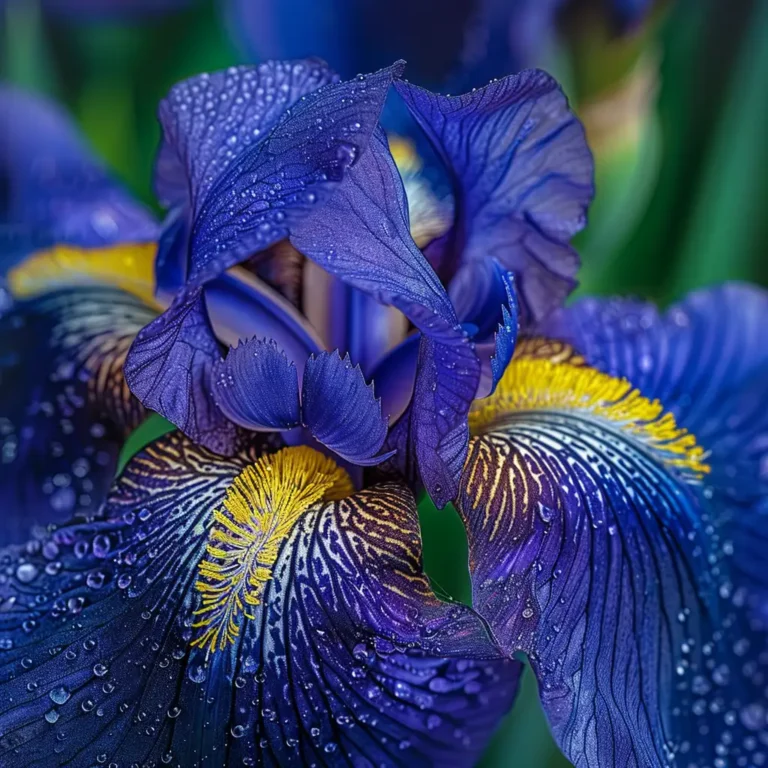Introduction
The Midnight Beauty Iris (Iris germanica) is a captivating addition to any garden, known for its deep, velvety-black blooms that add a dramatic flair to the landscape. This perennial favorite is not only visually stunning but also relatively easy to cultivate, making it a popular choice among gardening enthusiasts. In this article, we’ll delve into the botanical characteristics, cultivation practices, and benefits of growing this beautiful plant.
Botanical Characteristics
The Midnight Beauty Iris, scientifically known as Iris germanica, belongs to the Iridaceae family. It is a tall, bearded iris that typically grows up to 36 inches in height. The plant features upright, lance-shaped leaves that provide a striking contrast to its dark, ruffled flowers. Each bloom showcases a unique combination of deep purple and black hues, creating a mesmerizing effect in the garden.
Growing Conditions
To ensure the healthy growth of Midnight Beauty Iris, it’s essential to provide the right growing conditions:
- Soil: Well-drained soil with a neutral to slightly acidic pH.
- Light: Full sun to partial shade. The plant thrives best with at least 6 hours of direct sunlight daily.
- Temperature: Hardy in USDA zones 3-9, tolerating a wide range of temperatures.
For more detailed guidance on iris care, refer to the Royal Horticultural Society’s Iris Care Guide.
Planting and Propagation
Planting and propagating Midnight Beauty Iris involves a few straightforward steps:
- Planting:
- Plant iris rhizomes in late summer to early fall.
- Space rhizomes 12-24 inches apart.
- Plant with the top of the rhizome just below the soil surface.
- Propagation:
- Division: Every 3-4 years, divide the rhizomes to prevent overcrowding.
- Seed: Less common and more time-consuming, but viable.
For additional tips on growing irises, visit Better Homes & Gardens’ Iris Growing Tips.
Watering and Fertilization
Proper watering and fertilization are crucial for the optimal growth of Midnight Beauty Iris:
- Watering:
- Water regularly during the growing season.
- Ensure the soil is well-drained to prevent root rot.
- Fertilization:
- Apply a balanced fertilizer in early spring.
- Avoid high-nitrogen fertilizers, which can promote excessive leaf growth at the expense of flowers.
Pest and Disease Management
While Midnight Beauty Iris is relatively resilient, it can be susceptible to certain pests and diseases:
- Pests:
- Common pests include iris borers and aphids.
- Regular inspection and appropriate insecticides can help control infestations.
- Diseases:
- Watch out for fungal diseases like leaf spot and root rot.
- Ensure proper spacing and air circulation to reduce the risk of disease.
Seasonal Maintenance
Seasonal care is vital to keep your Midnight Beauty Iris thriving year-round:
- Spring:
- Remove any winter mulch.
- Apply a balanced fertilizer.
- Summer:
- Deadhead spent blooms to encourage new growth.
- Water consistently during dry periods.
- Fall:
- Divide and replant crowded rhizomes.
- Apply a layer of mulch to protect against winter frost.
- Winter:
- Minimal care needed.
- Ensure mulch remains in place to protect the rhizomes.
Landscaping with Midnight Beauty Iris
Midnight Beauty Iris can be a stunning focal point in any garden design:
- Garden Design:
- Use as a border plant or in mass plantings for dramatic effect.
- Pair with lighter-colored flowers to highlight its dark blooms.
- Companion Plants:
- Combine with plants like peonies, daylilies, and ornamental grasses.
- Consider foliage plants like hostas for textural contrast.
Benefits of Growing Midnight Beauty Iris
There are several benefits to growing Midnight Beauty Iris:
- Ecological:
- Attracts pollinators such as bees and butterflies.
- Provides habitat for beneficial insects.
- Aesthetic:
- Adds visual interest and depth to the garden.
- Creates a unique and eye-catching display.
Varieties and Hybrids
The world of irises offers a variety of stunning hybrids and cultivars:
- Varieties:
- Midnight Treat: Known for its deep purple and black ruffled blooms.
- Midnight Majesty: Features dark purple petals edged in gold.
Each variety boasts unique characteristics, making them a versatile choice for different garden styles.
FAQs
What are the ideal growing conditions for Midnight Beauty Iris?
Midnight Beauty Iris thrives in well-drained soil with full sun exposure and can tolerate a range of temperatures in USDA zones 3-9.
How often should I water my Midnight Beauty Iris?
Water regularly during the growing season, ensuring the soil is well-drained to prevent root rot.
What are common pests and diseases, and how do I treat them?
Common pests include iris borers and aphids. Diseases such as leaf spot and root rot can be prevented with proper spacing and air circulation.
How do I propagate Midnight Beauty Iris?
Propagate by dividing rhizomes every 3-4 years or by seed, though division is more common and effective.
Can Midnight Beauty Iris be grown in containers?
Yes, with proper care, Midnight Beauty Iris can be successfully grown in containers. Ensure good drainage and regular watering.
Conclusion
The Midnight Beauty Iris is a stunning and versatile addition to any garden, offering dramatic blooms and ease of care. Whether you’re a seasoned gardener or a beginner, this beautiful plant is sure to enhance your landscape with its unique beauty and charm. Embrace the allure of the Midnight Beauty Iris and enjoy the countless benefits it brings to your garden.

